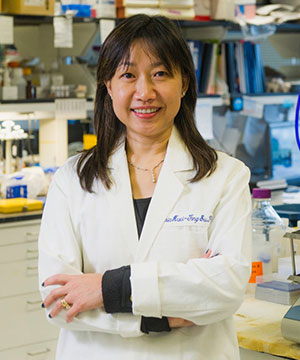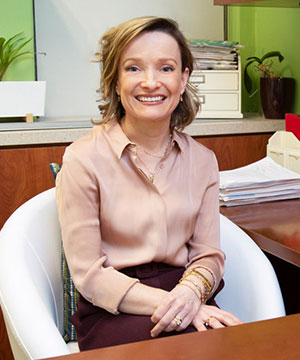Novel Approaches to Head & Neck Surgery
Exploring Molecular Drivers of Head and Neck Cancers

Gloria H. Su, PhD, Professor of Pathology and Cell Biology in Otolaryngology/Head and Neck Surgery and the Herbert Irving Comprehensive Cancer Center at Columbia
Columbia University scientists at the Herbert Irving Comprehensive Cancer Center have created laboratory models to study tumorigenesis and identify signaling pathways and biomarkers involved in head and neck cancer development and progression. One model was established with mutations in the PI3KCA oncogene, which is involved in multiple cancers. Using whole genome sequencing and other methods, the researchers have found that more than 10 percent of patients with these cancers have PI3KCA mutations. Numerous anticancer agents are being evaluated in clinical trials that target the PI3K signaling axis, so gaining an understanding of the role of this protein and its signaling pathway in head and neck cancer development may unveil new treatment options for patients whose tumors are driven by this oncogenic mutation.
The p16 tumor suppressor gene is often missing in head and neck cancers that are negative for the human papillomavirus (HPV). Patients with HPV-negative head and neck cancers have poorer outcomes than those with HPV-positive tumors. The Columbia University investigators created a second laboratory model in which the p16 gene is deleted. CDK inhibitors, several of which are already marketed for cancer treatment, may be therapeutic options for patients whose cancers are lacking this gene. The scientists hope to use both the PI3KCA and p16 models to test new therapeutic approaches. They also hope to use liquid biopsies to search for downstream biomarkers in patients who may have multiple mutations.
Head and neck cancers are continuing to increase in incidence due to their link with HPV. The Herbert Irving Comprehensive Cancer Center has expanded its head and neck cancer research program by recruiting several new investigators. All of the scientists meet monthly to discuss their research and pool their ideas to forge new collaborations and glean new avenues of study.
NewYork-Presbyterian Morgan Stanley Children’s Hospital is home to the only multidisciplinary tracheostomy care program for children in New York City and one of only a few such comprehensive tracheostomy programs in the country.
Facial Plastic Surgery

Susannah Hills, MD, pediatric otolaryngologist, NewYork-Presbyterian/Columbia
Our teams include otolaryngologists with additional fellowship training in facial plastic and reconstructive surgery. They provide treatment for conditions and deformities related to trauma and cancer and a wide range of elective cosmetic procedures, including:
- Repair of head and neck trauma and complicated facial fractures
- Plastic and reconstructive surgery for patients who have had large excisions
- Cosmetic procedures of the face and neck to restore form and function
- Complex craniofacial reconstruction in children and adults
Our head and neck reconstructive plastic surgeons are conducting research related to nerve and cartilage regeneration, which would allow for more comprehensive facial restoration following disfiguring congenital, oncologic, or traumatic defects. They’re also using 3D printing to design components for facial reconstruction.
Pediatric Tracheostomy Care
NewYork-Presbyterian Morgan Stanley Children’s Hospital is home to the only multidisciplinary tracheostomy care program for children in New York City. Established in 2018, our pediatric Tracheostomy Care Program is one of only a few such comprehensive tracheostomy programs in the country. The mission of the program is to provide the highest quality of care and support for children with tracheostomies and their families. These include children who are ventilator-dependent with a history of extreme prematurity and underdeveloped lungs, as well as children with congenital airway obstruction, laryngotracheal stenosis, tracheomalacia, and chronic neuromuscular disorders. Tracheostomy can be an intermittent treatment for children until they outgrow ventilator dependence or undergo surgical correction of an anatomic obstruction to breathing. For others, tracheostomy may be a long-term part of life.
Through the program, patients and their families are provided with a support system that features a comprehensive team of specialists to promote optimal respiration, feeding, and speech/language abilities. Led by a pediatric otolaryngologist who is a specialist in endoscopic airway surgery, airway reconstruction, and tracheostomy care, the team also includes speech/language pathologists, pulmonologists, nurses, and medical assistants. Also key to the program is a tracheostomy care coordinator who helps families bridge the transition from inpatient to outpatient care, ensuring they have the proper training they need to care for their child at home, obtain needed home equipment and services – such as 24-hour nursing and care from speech/language, physical, and occupational therapists – and other resources to support their child.
The hospital offers a monthly clinic just for tracheostomy patients, some of whom require clinical visits once or twice a month while others may only need to come in once or twice annually. Having a child who needs a tracheostomy dramatically changes family dynamics and home life, and the NewYork-Presbyterian Morgan Stanley Children’s Hospital team prepares, trains, and supports families adjusting to this transition, as well as the transition back to normal breathing in children whose tracheostomy tubes can be removed. Many children with tracheostomies learn to speak, and are able to eat, drink, and play. Through this dedicated program, the team helps each child to thrive and achieve the best quality of life possible.
Selected Publications
- Idiopathic chronic parotitis: Imaging findings and sialendoscopic response. ORL; Journal of Oto-Rhino-Laryngology and its Related Specialties. 2015;77(5):302-9
- Sialoendoscopy in the diagnosis and management of obstructive sialadenitis. The Laryngoscope. 2011;121(3):495-500.
- Building an endoscopic ear surgery program. Current Opinion in Otolaryngology and Head and Neck Surgery. 2016;24(5):395-401.
- Quality of life after combined endonasal endoscopic odontoidectomy and posterior suboccipital decompression and fusion. World Neurosurgery. 2018;116:e571-e576.
- Endoscopic pituitary surgery: A systematic review and meta-analysis. Journal of Neurosurgery. 2009;111(3):545-54.
- Predictors of short-term outcomes following endoscopic pituitary surgery. Clinical Neurology and Neurosurgery. 2009;111(2):119-22.
- Endoscopic cranial base surgery: Classification of operative approaches. Neurosurgery. 2008;62(5):991-1002.
- Localization of small parathyroid adenomas using modified 4-dimensional computed tomography/ultrasound. Otolaryngology Head and Neck Surgery. 2012;146(1):33-39.
- Parathyroid localization and preservation during transcervical resection of substernal thyroid glands. Otolaryngology Head and Neck Surgery. 2015;152(6):1024-28.
- Dysregulations in the PI3K pathway and targeted therapies for head and neck squamous cell carcinoma. Oncotarget. 2017;8(13):22203-17.
- Impact of PI3K/AKT/mTOR pathway activation on the prognosis of patients with head and neck squamous cell carcinomas. Oncotarget. 2016;7(20):29780-93.
- Novel mutant-enriched sequencing identified high frequency of PIK3CA mutations in pharyngeal cancer. International Journal of Cancer. 2008;122(5):1189-94.
- PIK3CA mutations in head and neck squamous cell carcinoma. Clinical Cancer Research. 2006;12(5):1441-46.



